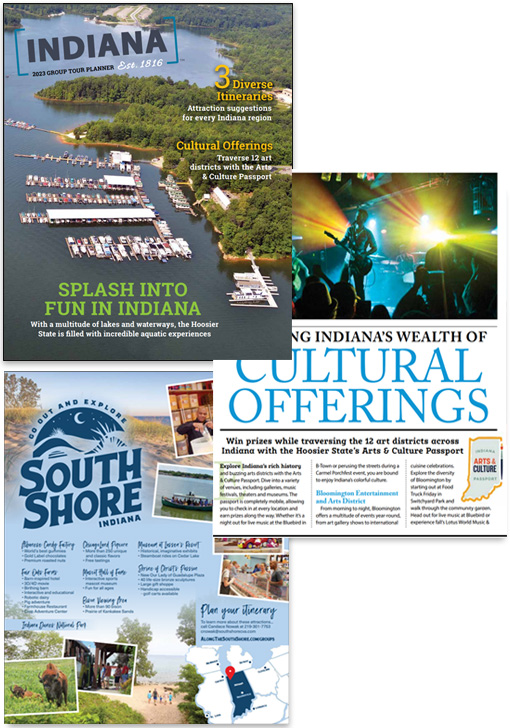Indiana Group Tour Planner
Download Issue2023 Edition
Indiana Group Tour Planner
During every visit to Indiana, you will discover new and exciting experiences that are unique to the Hoosier State. Come and relax on the beaches of the Indiana Dunes National Park. Enjoy the rolling hills on the Ohio River Scenic Byway or return to simpler times in Amish Country. Stop at one of Indiana’s wineries, farmers’ markets or creameries to experience the tastes of small-town Indiana. Indiana’s cities offer world-class museums, award-winning restaurants, performing arts and sporting events.
There are many resources Indiana offers group tours. Whether it is vineyards, breweries and distilleries, shopping, hiking, heritage or historical sites that you seek, start your planning at VisitIndiana.com.

Articles & Itineraries
- SAMPLING INDIANA’S WEALTH OF CULTURAL OFFERINGS – WIN PRIZES WHILE TRAVERSING THE 12 ART DISTRICTS ACROSS INDIANA
- FROM HISTORIC PERFORMANCE VENUES TO STATE-OF-THE-ART THEATERS, INDIANA HAS IT ALL – THESE CLASSIC THEATERS WILL ENTERTAIN GROUPS OF ALL AGES
- SPLASH INTO FUN IN INDIANA – WITH A WEALTH OF LAKES AND WATERWAYS
Sample Itineraries
Population
- Statewide: 6.8 million
- Indianapolis: 901,082 (also the state capital)
- Fort Wayne: 265,926
- Evansville: 117,272
- South Bend: 103,909
- Carmel: 103,871
- Fishers: 101,171
Getting Here by Air
- Indianapolis International Airport (IND):
Served by Air Canada, Alaska, Allegiant, American,
Contour, Delta, Frontier, Southwest, Spirit, United - South Bend International Airport (SBN):
Served by Allegiant, American, Delta, United - Evansville Regional Airport (EVV):
Served by Allegiant, American, Delta, United - Fort Wayne International Airport: (FWA):
Served by Allegiant, American, Delta
Getting Here by Rail
Amtrak stations in Connersville (COI), Crawfordsville
(CRF), Dyer (DYE), Elkhart (EKH), Hammond-Whiting
(HMI), Indianapolis (IND), Lafayette (LAF), Michigan
City (MCI), Rensselaer (REN), South Bend (SOB),
Waterloo (WTI)
Average Temperature by Season
- North – Spring 71, Summer 81, Fall 63, Winter 31
- Central – Spring 73 Summer 84, Fall 65, Winter 36
- South – Spring 77, Summer 88, Fall 70, Winter 41
Video Showcase
We’ve included some of the best videos from Visit Indiana; We hope you enjoy them.

